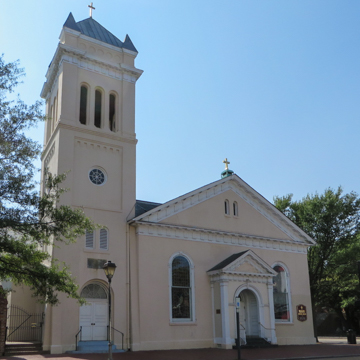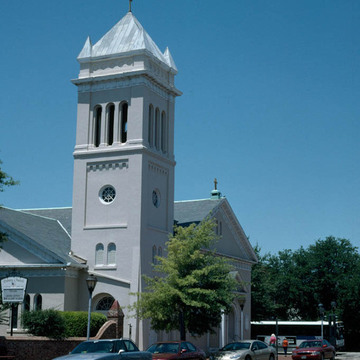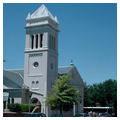Trinity Episcopal, the city's oldest religious congregation, was formed from the subdivision of the Elizabeth River Parish in 1761. The first church was constructed of brick the following year. Although the parish survived disestablishment, it became inactive between 1809 and 1820. During an attempted enlargement in 1828 the parish leaders determined that the building's fabric had deteriorated to such an extent that they decided to construct an entirely new church instead. Rectangular in shape, the stucco-over-brick church is oriented east-west, with a small, enclosed portico on Court Street to define the main entrance and an apse projecting from the west wall. The new structure retained eighteenth-century-style round-arched windows combined with a Greek Revival wooden Doric entablature below the eaves and a pedimented gable facing Court Street. A small belfry once crowned the gable over the main facade. The church's picturesque appearance dates from the 1890s, when the quasi-Romanesque tower and annex were added to the south side of the building and the belfry was removed. Several of the stained glass windows were designed by Henry Sharp of New York and installed in 1859. An 1868 stained glass window is the city's first Confederate memorial. The controversy that followed its installation—close on the heels of the Civil War—resulted in its removal for two years while a more acceptable inscription was composed. Three later windows are by Tiffany Studios.
You are here
Trinity Episcopal Church
1828–1830. 1884, renovation. 1893, annex and tower addition, W. D. Wentworth. 1961–1962, renovation, Williams and Tazewell. 1954–1956, parish house, Williams, Coile and Blanchard. 500 Court St.
If SAH Archipedia has been useful to you, please consider supporting it.
SAH Archipedia tells the story of the United States through its buildings, landscapes, and cities. This freely available resource empowers the public with authoritative knowledge that deepens their understanding and appreciation of the built environment. But the Society of Architectural Historians, which created SAH Archipedia with University of Virginia Press, needs your support to maintain the high-caliber research, writing, photography, cartography, editing, design, and programming that make SAH Archipedia a trusted online resource available to all who value the history of place, heritage tourism, and learning.








